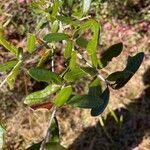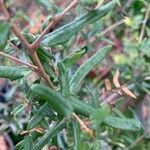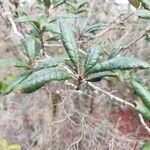Trees, sometimes shrubs , subevergreen, trees to 25 m, shrubs sometimes rhizomatous (if spreading rhizomatously, without numerous straight, short, erect stems emerging from gound, or if so, mixed with other larger branches, infertile, and without dimorphic or asymmetric leaf form). Bark dark brown or black, scaly. Twigs yellowish, becoming light gray, 1.5-3 mm diam., tomentulose, glabrate in 2d year. Buds reddish or dark brown, globose or ovoid, 1-2.5(-3) mm; scale margins glabrous or puberulent. Leaves: petiole 3-10(-20) mm. Leaf blade narrowly lanceolate or elliptic, rarely orbiculate, convex-cupped, (10-)35-60(-120) × (7-)10-30(-45) mm, base narrowly cuneate, rarely truncate or rounded, margins strongly revolute, entire, secondary veins 8-10(-12) on each side, apex acute, sometimes obtuse; surfaces abaxially whitish or glaucous, densely covered with minute, appressed, fused-stellate hairs (visible under magnification), and with additional scattered, erect, felty or spreading hairs (sometimes deciduous), or light green and glabrate in shade leaves, adaxially dark or light green, glossy, glabrous or with minute, scattered, stellate hairs, secondary veins moderately to deeply impressed. Acorns 1-3, on peduncle 10-100 mm; cup hemispheric or deeply goblet-shaped, sometimes saucer-shaped, 8-15 mm deep × 5-15 mm wide, base often constricted, scales whitish or grayish, thickened basally, keeled, acute-attenuate, tomentulose, tips reddish, glabrous or puberulent; nut dark brown, ovoid, barrel-shaped, or acute, (13-)15-20(-25) × (8-)9-12(-15) mm, glabrous. Cotyledons connate.
More
Much like no. 11 [Quercus virginiana Mill.], often smaller; lvs revolute-margined, the upper surface often rounded rather than plane; pubescence of the lower lf-surface coarse and looser, the individual stellae readily visible at 20×, often even at 10×; main veins impressed on the upper lf-surface, elevated on the lower; acorns commonly paired. Dry or moist soil on the coastal plain; se. Va. to Fla. and Miss. (Q. virginiana var. maritima, the dwarf phase)




